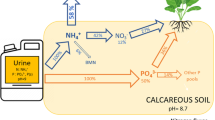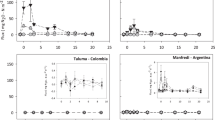Abstract
Soil moisture and compaction, and source of N and bovine urine can reduce methane (CH4) rates from agricultural soils. However, the magnitude of the effect is unknown in tropical soil under different conditions, as well as the potential of different urine-N concentration, volume, and sources of N in such an effect. This study aimed to investigate the effects of different soil conditions (moist, dry, compacted, moist-dung, moist-dung-compacted), N concentration in urine (2.5, 5.0, 10.0, and 15.0 g N L−1), volume of urine (25, 50, 100, and 200 ml kg−1 dry soil), and source of N (ammonium, nitrate, and urea) on CH4 emissions. A tropical Ferralsol soil from marandu-grass pasture was incubated during 106 days and the CH4 concentration determined by gas chromatography. The CH4 rates varied significantly according to the soil conditions when manipulated the urine-N (p < 0.01) and averaged 0.75, − 0.50, 1.14, 6.23, and 8.17 μg C–CH4 m−2 h−1for the moist, dry, compacted, moist-dung, and moist-dung-compacted soil, respectively, and, not responded to the level of N (p = 0.73) averaging 2.57 μg C–CH4 m−2 h−1. When evaluated, the volumes of urine cumulative CH4 averages were − 0.52, − 1.24, − 0.88, 14.48, and 18.56 μg C–CH4 m−2 h−1 for the moist, dry, compacted, moist-dung, and moist-dung-compacted, respectively. Soils were affected by soil treatments (p < 0.001) but not by urine volumes (p = 0.30). The source of N did not influence the CH4 rates (p = 0.1) averaging 0.88, − 1.26, and − 1.19 μg C–CH4 m−2 h−1 respectively, for urea, nitrate, and ammonium. The CH4 fluxes in tropical Ferralsols are controlled by the soil characteristics and dung addition.


Similar content being viewed by others
References
Acton SD, Baggs EM (2011) Interactions between N application rate, CH4 oxidation and N2O production in soil. Biogeochemistry 103:15–26
Alluvione F, Halvorson AD, Del Grosso SJ (2009) Nitrogen, tillage, and crop rotation effects on carbon dioxide and methane fluxes from irrigated cropping systems. J Environ Qual 38:2023–2033
Alves BJR, Smith KA, Flores RA, Cardoso AS, Oliveira WRD, Jantalia CP, Urquiaga S, Boddey RM (2012) Selection of the most suitable sampling time for static chambers for the estimation of daily mean N2O flux from soils. Soil Biol Biochem 46:129–135
Baggs EM, Blum H (2004) CH4 oxidation and emissions of CH4 and N2O from Lolium perenne swards under elevated atmospheric CO2. Soil Biol Biochem 36:713–723
Bodelier PLE (2011) Interactions between nitrogenous fertilizers and methane cycling in wetland and upland soil. Curr Opin Environ Sustain 3:379–388
Bodelier PLE, Laanbroek HJ (2004) Nitrogen as a regulatory factor of methane oxidation in soils and sediments. FEMS Microbiol Ecol 47:265–277
Cardoso AS, Alves BJR, Urquiaga S, Boddey RM (2018) Effect of volume of urine and mas of feces on N2O and CH4 emissions of dairy cow excreta in a tropical pasture. Anim Prod Sci 58:957–962
Chan ASK, Parkin TB (2001) Effect of land use on methane flux from soil. J Environ Qual 30:786–797
Conrad R (2007) Microbial ecology of methanogens and methanotrophs. Adv Agron 96:1–63
Dalal RC, Allen DE, Livesley SJ, Richards G (2008) Magnitude and biophysical regulators of methane emission and consumption in the Australian agricultural, forest, and submerged landscapes: a review. Plant Soil 309:43–76
Doak BW (1952) Some chemical changes in the nitrogenous constituents of urine when voided on pasture. J Agric Sci 42:162–171
Dobbie KE, Smith KA (1996) Comparison of CH4 oxidation rates in woodland, arable and set aside soils. Soil Biol Biochem 28:1357–1365
Drewry JJ, Cameron KC, Buchan GD (2008) Pasture yield and soil physical property responses to soil compaction from treading and grazing—a review. Soil Res 46:237–256
Fender AC, Pfeiffer B, Gansert D, Leuschner C, Daniel R, Jungkunst HF (2012) The inhibiting effect of nitrate fertilisation on methane uptake of a temperate forest soil is influenced by labile carbon. Biol Fertil Soils 48:621–631
Garcia JL, Patel BKC, Ollivier B (2000) Taxonomic, phylogenetic, and ecological diversity of methanogenic Archae. Anaerobe 6:205–226
Gonzalez-Avalos E, Ruiz-Suarez LG (2001) Methane emission factors from cattle manure in Mexico. Bioresource Technol 80:63–71
Gulledge J, Hrywna Y, Cavanaugh C, Steydler PA (2004) Effects of long-term nitrogen fertilisation on the uptake kinetics of atmospheric methane in temperate forest soils. FEMS Microbiol Ecol 49:389–400
Holmes AJ, Costello A, Lidstrom ME, Murrell JC (1995) Evidence that particulate methane monooxygenase and ammonia monooxygenase may be evolutionarily related. FEMS Microbiol Lett 132:203–208
Hütsch BW (1998) Methane oxidation in arable soil as inhibited by ammonium, nitrite and organic manure with respect to soil pH. Biol Fertil Soils 28:27–35
Hütsch BW (2001) Methane oxidation in non-flooded soils as affected by crop production - invited paper. Eur J Soil Sci 14:237–260
IPCC (2013) AR5 WG1 “climate change 2013: the physical science basis - anthropogenic and natural radiative forcing supplementary material”. Cambridge University Press, Cambridge
Jarvis SC, Lovell RD, Panayides R (1995) Patterns of methane emissions from excreta of grazing cattle. Soil Biol Biochem 27:1581–1588
Kravchenko I, Boeckx P, Galchenko V, Van Cleemput O (2002) Short- and medium-term effects of NH4? On CH4 and N2O fluxes in arable soils with a different texture. Soil Biol Biochem 34:669–678
Le Mer J, Roger P (2001) Production, oxidation, emission and consumption of methane by soils: a review. Eur J Soil Biol 37:25–50
Lindau CW (1994) Methane emissions from Louisiana rice fields amended with nitrogen fertilizers. Soil Biol Biochem 26:353–359
Liu LL, Greaver TL (2009) A review of nitrogen enrichment effects on three biogenic GHGs: the CO2 sink may be largely offset by stimulated N2O and CH4 emission. Ecol Lett 12:1103–1117
Mazzetto AM, Barneze AS, Feigl BJ, van Groenigen JW, Oenema O, Cerri CC (2014) Temperature and moisture affect methane and nitrous oxide emission from bovine manure patches in tropical conditions. Soil Biol Biochem 76:242–248
Mosier AR, Schimel D, Valentine D, Bronson K, Parton W (1991) Methane and nitrous oxide fluxes in native, fertilised and cultivated grasslands. Nature 350:330–332
Mosier AR, Wassmann R, Verchot L, King J, Palm C (2004) Methane and nitrogen oxide fluxes in tropical agricultural soils, sources, sinks and mechanisms. Environ Dev Sustain 6:1–49
Oenema O, Velthof GL, Yamulki S, Jarvis SC (1997) Nitrous oxide emissions from grazed grassland. Soil Use Manag 13:288–295
Ramanathan VL, Callis R, Cess J, Hansen I, Isaksen W, Kuhn A, Lacis F, Luther J, Mahlman R, Schlesinger M (1987) Climate-chemical interactions and effects of changing atmospheric trace gases. Rev Geophys 25:1441–1482
Saggar S, Bolan NS, Bhandral R, Hedley CB, Luo JA (2004) Review of emissions of methane, ammonia, and nitrous oxide from animal excreta deposition and farm effluent application in grazed pastures. NZ. J Agric Res 47:513–544
Serrano-Silva N, Valenzuela-Encinas C, Marsch R, Dendooven L, Alcántara-Hernández RJ (2014) Changes in methane oxidation activity and methanotrophic community composition in saline alkaline soils. Extremophiles 18:561–571
Sherlock RR, de Klein CAM, Li Z (2003) Determination of N2O and CH4 emission factors from animal excreta, following a summer application in 3 regions of New Zealand. A Final Report of an NzOnet Study Prepared for the Ministry of Agriculture and Forestry, New Zealand, p. 27
Veldkamp E, Weitz AM, Keller M (2001) Management effects on methane fluxes in humid tropical pasture soils. Soil Biol Biochem 33:1493–1499
Wang ZP, Lindau CW, Delaune RD, Patrick WH (1993) Methane emission and entrapment in flooded rice soils as affected by soil properties. Biol Fertil Soils 16:163–168
Werner C, Kiese R, Butterbach-Bahl K (2007) Soil-atmosphere exchange of N2O, CH4 and CO2 and controlling environmental factors for tropical rain forest sites in western Kenya. J Geophys Res 112:1–15
Whalen SC (2005) Biogeochemistry of methane exchange between natural wetlands and the atmosphere. Environ Eng Sci 22:73–92
WMO (2015) The state of greenhouse gases in the atmosphere based on global observations through 2014. WMO Greenhouse Gas Bull 11:1–4
Xie B, Zheng X, Zhou Z, Gu J, Zhu B, Chen X, Shi Y, Wang Y, Zhao Z, Liu C, Yao Z, Zhu J (2010) Effects of nitrogen fertilizer on CH4 emission from rice fields: multi-site field observations. Plant Soil 326:393–401
Yamulki S, Jarvis SC, Owen P (1999) Methane emission and uptake from soils as influenced by excreta deposition from grazing animals. J Environ Qual 28:676–682
Zanatta JA, Bayer C, Vieira FCB, Gomes J, Tomazi M (2010) Nitrous oxide and methane fluxes in South Brazilian Gleysol as affected by nitrogen fertilizers. Rev Bras Cien Solo 34:1653–1665
Zeiss CA (2006) Accelerated methane oxidation cover system to reduce greenhouse gas emissions from MSW landfills in cold, semi-arid regions. Water Air Soil Pollut 176:285–306
Acknowledgements
The authors ASC, TSN, and ESM thank FAPESP for scholarships. The authors ACR, LFB, and ERJ are grateful to the Conselho Nacional de Desenvolvimento Científico Tecnológico (CNPq) and Coordenação de Aperfeiçoamento de Pessoal de Nível Superior (CAPES) for scholarships. Partial data of the present work were previously published in the VII Brazilian Congress of the Biometeorology, Ambience, Behavior and Animal Welfare (VII CBBiomet).
Funding
This work was financially supported by the Fundação de Amparo a Pesquisa do Estado de São Paulo “São Paulo Research Foundation” (FAPESP grant nos. 2011/00060-8, 2012/06718-8, 2012/04605-1, 2013/11898-8, 2013/24782-8)
Author information
Authors and Affiliations
Corresponding author
Ethics declarations
Conflict of interest
The authors declare that they have no conflict of interest.
Ethical standards
This manuscript complied with the current laws of the Brazil.
Rights and permissions
About this article
Cite this article
Cardoso, A.d., Quintana, B.G., Janusckiewicz, E.R. et al. How do methane rates vary with soil moisture and compaction, N compound and rate, and dung addition in a tropical soil?. Int J Biometeorol 63, 1533–1540 (2019). https://doi.org/10.1007/s00484-018-1641-0
Received:
Revised:
Accepted:
Published:
Issue Date:
DOI: https://doi.org/10.1007/s00484-018-1641-0




